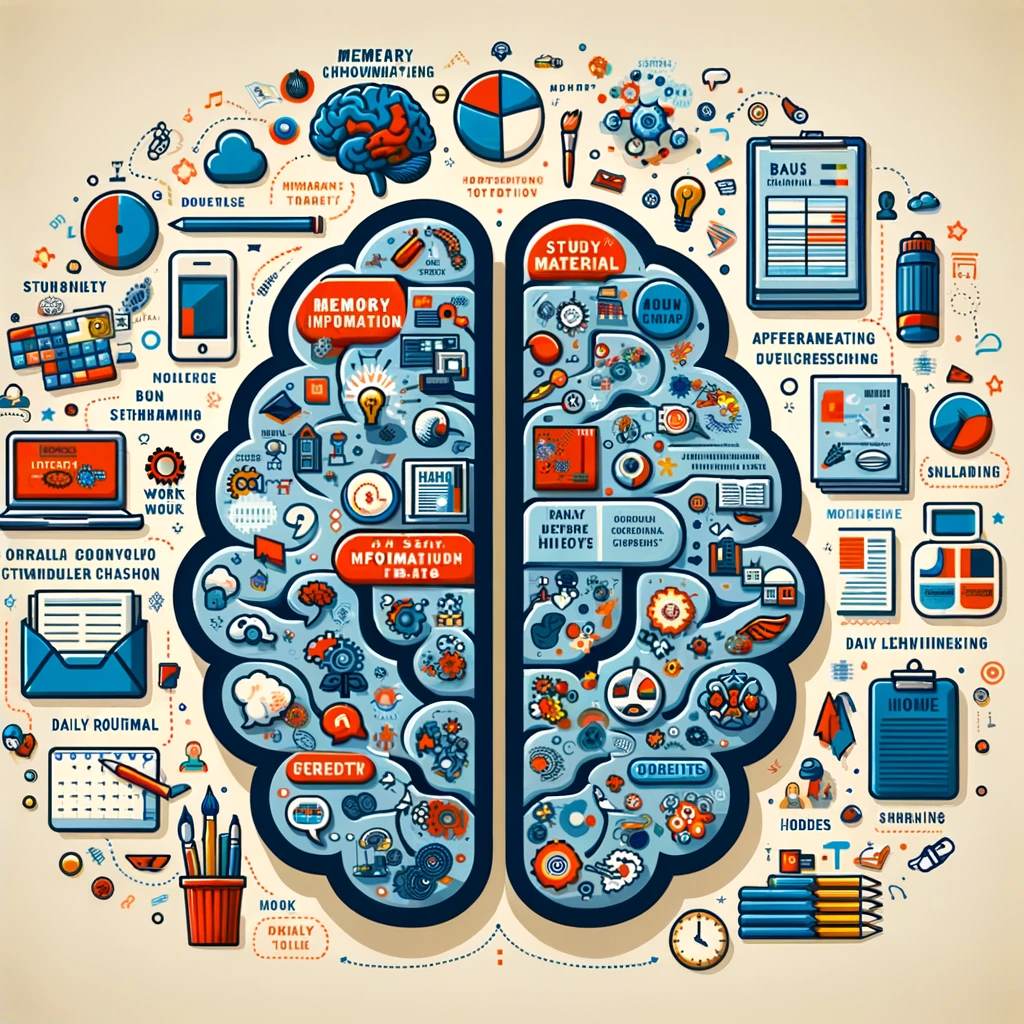The Magic of Chunking
Have you ever marveled at how some people can remember vast amounts of information effortlessly? It turns out there’s a secret technique that can unlock this superpower in all of us. It’s called “memory chunking,” and it’s not just for geniuses—it’s a tool we can all use to boost our memory in everyday life.
Memory chunking stands out as a beacon of hope for those of us looking to navigate the vast seas of information that flood our daily lives. This simple, yet incredibly powerful strategy is not just about memorizing facts or figures; it’s about transforming the way we process, store, and retrieve information, making learning and remembering a more manageable, enjoyable, and ultimately successful endeavor.
Memory chunking is about organizing information into bite-sized pieces that our brains can easily digest. Much like how a well-organized bookshelf allows you to find exactly what you’re looking for without the stress of sifting through a cluttered pile of books, chunking helps streamline the cognitive process. It’s akin to finding a secret passage through a dense forest of data, leading us to clearer understanding and retention.
This technique is grounded in the cognitive psychology principle that our working memory—our mental workspace for processing and manipulating information—has limited capacity. By grouping related information together into “chunks,” we effectively expand the boundaries of our mental workspace, enabling us to hold and understand more information at once. It’s a testament to the adaptability of the human mind and its remarkable ability to find order in chaos.
But chunking is more than just a memory hack; it’s a reflection of our innate tendency to seek patterns and connections in the world around us. It leverages this natural propensity to enhance our cognitive efficiency, making it a universally applicable tool across various domains of life, from studying for exams to organizing our daily tasks and learning new skills.
The Science Behind Memory Chunking
Memory chunking is like organizing your closet. Just as you group clothes by type or season for easy retrieval, chunking groups information into bite-sized pieces that our brains find easier to process and remember. Research shows our short-term memory can hold about 7 items at once, give or take a few. Chunking leverages this by combining information into meaningful units, expanding what we can remember.
Understanding Working Memory
Working memory is a core component of our cognitive system, allowing us to hold and manipulate information in our minds over short periods. It’s what we use to plan, solve problems, and carry out complex tasks. However, working memory has its limits; research by cognitive psychologist George A. Miller in the 1950s suggested that the average person can hold about 7 (plus or minus 2) items in their working memory at one time. This limitation underscores the necessity of memory strategies like chunking.
The Role of Chunking in Enhancing Memory
Chunking helps us overcome the limitations of working memory by organizing information into more manageable units or chunks. This organization makes the information more meaningful and easier to remember. When we chunk information, we reduce the cognitive load on our working memory, allowing us to process and store more information than we could otherwise.
Neuroscience Behind Chunking
Neuroscientific research supports the effectiveness of chunking, showing that it can influence how information is encoded and retrieved in the brain. When we chunk information, we’re essentially creating shortcuts that help our brains bypass the limitations of working memory capacity.
Studies using functional magnetic resonance imaging (fMRI) have shown that chunking can alter the way information is represented in the brain, with certain patterns of brain activity associated with more efficient memory storage and retrieval. This suggests that chunking not only helps in the short-term management of information but also facilitates the long-term storage of information in the hippocampus and other areas of the brain involved in memory.
Practical Implications of Chunking
The implications of chunking extend far beyond academic study or memory competitions. In everyday life, chunking can enhance our ability to remember important information, learn new skills, and improve our productivity. For example, in education, chunking material into smaller, logically organized units can help students better understand and retain complex information. In the workplace, chunking tasks and information can improve efficiency and reduce errors.
Enhancing Memory Through Chunking
To maximize the benefits of chunking, it’s important to:
- Identify patterns and connections in the information you want to remember. This could involve grouping items by category, sequence, or any other logical association.
- Use mnemonic devices to create meaningful associations between chunks of information. Mnemonics can serve as powerful tools for enhancing memory.
- Practice regularly to reinforce the chunks in your memory. The more you review and use the information, the stronger and more accessible those memory chunks will become.
Real-Life Examples
Remembering Phone Numbers
Consider how phone numbers are typically divided into segments rather than a long string of digits. This isn’t by accident. It’s chunking in action, making numbers more memorable.
Grocery Shopping Without a List
Imagine grouping your grocery needs by department: all fruits together, all dairy together, and so on. This method of chunking by category can help you remember your list without writing it down.
Learning a New Language
When mastering a new language, breaking down sentences into chunks—such as subjects, verbs, and objects—can make learning faster and more effective than trying to memorize entire sentences or vocabulary lists.
Educational Learning
Studying for Exams: A student preparing for a history exam can group information into chunks based on time periods, geographical locations, or key figures. For instance, memorizing dates and events becomes easier when they are associated with the story or narrative of a particular era. By chunking study material in this way, students can improve recall and deepen their understanding of connections within the material.
Professional Settings
Presentations and Meetings: Professionals often use chunking to organize presentations or meetings. Breaking down the agenda or content into specific sections (e.g., introduction, objectives, main points, conclusion) helps both the presenter and the audience to follow along more easily. This method enhances the retention of information and ensures that key points are communicated effectively.
Daily Life
Organizing a To-Do List: In personal organization, chunking can be applied to manage tasks more efficiently. For example, instead of a long list of tasks, one might group them into categories such as errands, household chores, work-related tasks, and personal projects. This approach not only makes the list more manageable but also helps in prioritizing and focusing on completing similar tasks together, boosting productivity.
Skill Acquisition
Learning to Play a Musical Instrument: When learning a new piece of music, musicians often break the piece into smaller sections or “chunks.” This could mean focusing on a particular measure, phrase, or even a challenging passage. Practicing these chunks individually before putting them together allows for more focused attention on difficult parts, leading to more efficient learning and mastery of the piece.
Memory Sports
Competitive Memorization: Participants in memory competitions often use chunking as a key strategy to memorize decks of cards, long numbers, or lists of words. For example, a competitor might group a sequence of numbers into chunks that represent meaningful dates or events, or use the method of loci to chunk information by placing groups of items along a familiar route in their mind.
Language Learning
Acquiring New Vocabulary: When learning a new language, chunking vocabulary into thematic groups (such as food, travel, family) can be more effective than random memorization. This not only helps in remembering the words but also in using them contextually. Additionally, learning phrases or sentences as chunks rather than individual words can accelerate language proficiency by understanding common patterns and usage.
Health and Wellness
Exercise Routines: In fitness, breaking down workouts into chunks based on muscle groups or types of exercise (e.g., cardio, strength, flexibility) can help individuals create balanced routines and stay motivated. This approach allows for targeted training and easier adjustment of workout plans to fit personal goals and progress.
Ancient Wisdom on Memory
Even the ancients recognized the power of organizing information. The philosopher Cicero, in his discussions on memory techniques, emphasized the importance of order and arrangement. He might not have used the term “chunking,” but the principle was the same: grouping information makes it easier to recall.
Ancient Greece
In ancient Greece, the technique of creating “memory palaces” was developed, a method also known as the Method of Loci. This technique involved visualizing a familiar space, such as a building or city, and placing vivid, memorable images in specific locations (loci) within that space to recall information. The famous Greek poet Simonides of Ceos is credited with the invention of this method after a tragic event where he was able to remember the exact seating arrangement of guests at a banquet that had collapsed, based on the spatial layout of the room.
Aristotle also contributed to the understanding of memory. He suggested that associating images with places could significantly enhance recall. His emphasis on the importance of the “association of ideas,” such as similarity, contrast, and contiguity, has influenced memory techniques for centuries.
Ancient Rome
Cicero, the Roman statesman and philosopher, further popularized the method of loci in his writings. In his work “De Oratore,” he describes how an orator can use this method to deliver long speeches without notes by associating parts of their speeches with different parts of a building they could mentally walk through.
Another Roman, Quintilian, also recommended using vivid and unusual images in these mental spaces to make them more memorable, a principle that is echoed in modern mnemonic devices.
Ancient India
In ancient India, the oral tradition of transmitting texts and knowledge, particularly in the Vedic tradition, was highly developed. Memorization techniques were critical for preserving the sacred texts, known as Vedas. The method of “Anukramanis,” which involved systematic indexing and categorization, helped in remembering complex materials. Additionally, techniques like repetition, musical chanting (Samhita Patha), and elaborate mnemonic systems (such as Jata Patha, where words are recited in a complex pattern) were used to ensure accuracy and preservation over generations.
Ancient China
The art of memory in ancient China was closely linked to the practice of meditation and the philosophy of Confucianism and Taoism. The use of rhymes and rhythm in texts, as seen in the classic “The Book of Changes” (I Ching), facilitated memorization. Confucius emphasized the importance of reflection and study, suggesting that the integration of new information with existing knowledge through contemplation was key to deep learning and memory.
The Benefits of Chunking
Aside from improving memory, chunking can also:
Enhances Memory Retention and Recall
Chunking significantly improves both the retention and recall of information. By organizing data into meaningful units, the brain can process and store information more efficiently. This method leverages existing knowledge structures, making it easier to retrieve information from long-term memory when needed.
Reduces Cognitive Load
One of the primary benefits of chunking is the reduction of cognitive load—the amount of mental effort being used in the working memory. By breaking down information into smaller, manageable units, chunking helps prevent information overload and facilitates a more focused and less stressful learning experience.
Improves Learning Efficiency
Chunking can accelerate the learning process by making complex information more digestible. When learners can identify patterns and relationships within the material, they’re able to grasp concepts more quickly and integrate new knowledge with what they already know, leading to deeper understanding and longer retention.
Aids in Organizing Information
Chunking is not just about memory; it’s also an effective organizational tool. Whether it’s structuring a speech, planning a project, or organizing daily tasks, chunking helps in laying out information in a more logical and accessible manner. This organization makes it easier to prioritize tasks, set goals, and execute plans systematically.
Facilitates Problem-Solving
In problem-solving, chunking allows individuals to break down complex problems into smaller, more manageable parts. This approach makes it easier to identify potential solutions for each part and how they might connect to solve the overall problem. By focusing on one “chunk” at a time, individuals can tackle complex issues without becoming overwhelmed.
Enhances Focus and Concentration
Chunking can also improve focus and concentration by providing clear, manageable goals. When information is organized into chunks, it’s easier to dedicate attention to one segment at a time, leading to more effective study or work sessions and reducing the likelihood of distraction.
Supports Creativity
By organizing information into chunks, individuals can more easily see connections and patterns that might not have been apparent otherwise. This recognition can spark creative thinking, as the recombination of different information chunks can lead to new ideas and insights.
Boosts Confidence
The sense of accomplishment from mastering one chunk of information at a time can boost learners’ confidence in their abilities. This incremental progress reinforces the belief that they can tackle challenging material, motivating them to continue learning and exploring new subjects.
How to Apply Chunking in Your Life
Identify the Information: Start with the material you want to remember.
Find Natural Groups: Look for patterns or categories that make sense.
Create Chunks: Organize the information into these groups.
Practice: Review the chunks regularly to reinforce your memory.
Here’s a comprehensive guide on integrating this powerful technique into various aspects of your routine:
Improving Study Habits
- Break Down Material: Divide your study content into themes, chapters, or concepts. For instance, when learning a new subject, identify key areas and focus on one at a time.
- Create Study Sessions: Allocate specific study sessions to each chunk, allowing your brain to focus deeply on one area before moving to the next.
Enhancing Work Productivity
- Organize Tasks: Group your work tasks by category, such as emails, meetings, project work, and administrative tasks. Tackling similar tasks in a single chunk can improve focus and efficiency.
- Project Management: Break down projects into phases, milestones, or specific tasks. This approach makes large projects more manageable and less daunting, facilitating better planning and execution.
Daily Planning and Time Management
- Plan Your Day in Chunks: Instead of a continuous stream of tasks, divide your day into chunks dedicated to work, exercise, leisure, and family time. This can help maintain a healthy balance and ensure dedicated focus for each aspect of your life.
- Use Themed Days: If possible, dedicate different days to different types of work or activities (e.g., creative tasks on one day, administrative tasks on another). This can help reduce cognitive switching costs and increase productivity.
4. Memory Enhancement
- Memorize Information: Use chunking to memorize information by grouping similar items together. For instance, if trying to remember a grocery list, group items by their department in the store (produce, dairy, etc.).
- Learn New Skills: When learning a new skill, break the learning process into smaller, manageable steps or stages. Master each chunk before moving on to the next.
Problem-Solving
- Break Down Problems: When faced with a complex problem, divide it into smaller parts. Solve each part individually before looking at how they fit together to solve the overall problem.
Creative Projects
- Organize Ideas: If you’re working on a creative project, such as writing a book or planning an art piece, organize your ideas into chunks. For writing, this could mean focusing on one chapter or section at a time.
Learning New Languages
- Chunk Vocabulary and Grammar: Learn new words and grammar rules in groups related to specific themes or situations. Practice these chunks in context to enhance retention and understanding.
Physical Exercise
- Workout Segmentation: Divide your workout into different sections (e.g., warm-up, cardio, strength training, cool down). This can help you maintain focus and ensure a comprehensive routine.
Cooking and Meal Preparation
- Meal Planning: Organize your meal prep into chunks, such as chopping vegetables, preparing proteins, and cooking grains. This approach can streamline the cooking process and reduce the time spent in the kitchen.
Personal Finances
- Manage Finances in Categories: Chunk your finances by categories such as bills, savings, investments, and discretionary spending. This can simplify financial management and help with budgeting.
Implementing Chunking Effectively
- Practice Regularly: Like any skill, effective chunking requires practice. The more you integrate it into your daily life, the more naturally it will come.
- Adjust Chunks Over Time: As you become more familiar with chunking, you may find that some chunks are too large or too small. Feel free to adjust the size of your chunks to better suit your memory capacity and attention span.
- Combine Chunking with Other Techniques: For maximum effectiveness, combine chunking with other cognitive and memory enhancement techniques, such as mnemonic devices, spaced repetition, and active recall.
By incorporating chunking into your daily routines and tasks, you can unlock a more organized, efficient, and productive way of living, making the most of your cognitive resources and time.
Conclusion
In wrapping up our exploration of memory chunking, it’s clear that this technique is more than just a memory aid; it’s a versatile tool that can significantly enhance various aspects of our daily lives. From improving learning efficiency and work productivity to simplifying complex information and boosting creative endeavors, chunking offers a practical approach to managing the vast amounts of information we encounter every day.
By organizing data into manageable, meaningful units, chunking helps overcome the limitations of our working memory, allowing us to process, store, and retrieve information more efficiently. This not only enhances our ability to remember but also facilitates deeper understanding, critical thinking, and problem-solving.
Applying chunking in our daily routines, whether through structured study sessions, organized work tasks, segmented daily planning, or even in the way we approach problem-solving and creative projects, can lead to significant improvements in productivity, learning, and overall cognitive performance. It teaches us the importance of breaking down seemingly overwhelming challenges into smaller, more manageable parts, a skill that is invaluable in all walks of life.
Moreover, the ancient wisdom and scientific backing of chunking serve as a testament to its enduring relevance and effectiveness. As we continue to navigate an increasingly complex world, filled with ever-growing information and demands on our attention, embracing and applying the principles of chunking can be a powerful step towards achieving not just greater efficiency, but also a more balanced and fulfilling life.
In conclusion, memory chunking is a testament to the adaptability and potential of the human mind. By leveraging this simple yet powerful strategy, we can enhance our cognitive capabilities, improve our learning and memory, and approach our daily tasks with greater confidence and ease. The journey of mastering chunking is one of discovery, not just of knowledge and information, but of our own untapped potential.
Final Thought
“To know, is to know that you know nothing. That is the meaning of true knowledge.” – Socrates. In the journey of lifelong learning, chunking is a tool that reminds us of the joy in discovering how much there is to know and the smart ways we can hold onto that knowledge.








